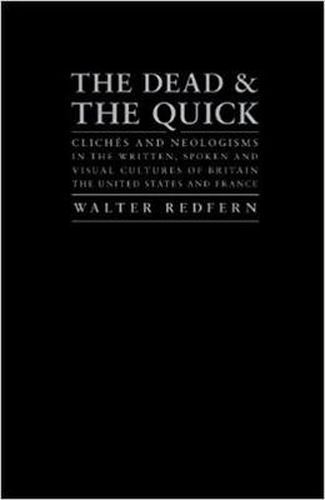Readings Newsletter
Become a Readings Member to make your shopping experience even easier.
Sign in or sign up for free!
You’re not far away from qualifying for FREE standard shipping within Australia
You’ve qualified for FREE standard shipping within Australia
The cart is loading…






This work is a major contribution to the study of cliches and neologisms since it moves beyond considering them separately into their interlinked role in written,spoken and visual cultures in contemporary Britain, France and the United States.
The general line of attack is a view of language as both reactionary and revolutionary. Language, Dr. Redfern points out, connives in our clinging to obsolete realities , and yet is constantly evolving by processes of displacement and substitution. Despite the allegedly static nature of cliche, this study focuses on the dynamic potentialities of language, whether via the reanimation of moribund ideas or by coinages from scratch. Among the many closely related analyzed in depth are: imitation,rumor, political correctness, jargon, euphemism, plagiarism, stereotyping (racial or otherwise), repetition, and caricature. This leads to a broader assessment of unthinking prose in English and French ( constipated thinking ) as well as various tactics for resisting and countervailing such practices. Linguistic creativity is discussed and the widespread hostility to new words is demonstrated by discussions of language purification and other protection systems.
As well as written and spoken forms of cliche and neologism, Redfern studies the visual domain (e.g. kitsch and the neomorphisms of psychotics)in a brief, witty summary of the issues at hand.
$9.00 standard shipping within Australia
FREE standard shipping within Australia for orders over $100.00
Express & International shipping calculated at checkout
This work is a major contribution to the study of cliches and neologisms since it moves beyond considering them separately into their interlinked role in written,spoken and visual cultures in contemporary Britain, France and the United States.
The general line of attack is a view of language as both reactionary and revolutionary. Language, Dr. Redfern points out, connives in our clinging to obsolete realities , and yet is constantly evolving by processes of displacement and substitution. Despite the allegedly static nature of cliche, this study focuses on the dynamic potentialities of language, whether via the reanimation of moribund ideas or by coinages from scratch. Among the many closely related analyzed in depth are: imitation,rumor, political correctness, jargon, euphemism, plagiarism, stereotyping (racial or otherwise), repetition, and caricature. This leads to a broader assessment of unthinking prose in English and French ( constipated thinking ) as well as various tactics for resisting and countervailing such practices. Linguistic creativity is discussed and the widespread hostility to new words is demonstrated by discussions of language purification and other protection systems.
As well as written and spoken forms of cliche and neologism, Redfern studies the visual domain (e.g. kitsch and the neomorphisms of psychotics)in a brief, witty summary of the issues at hand.